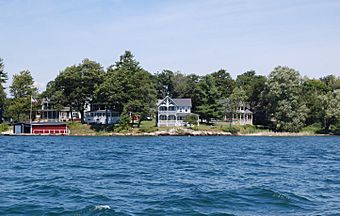Thousand Island Park Historic District facts for kids
Quick facts for kids |
|
|
Thousand Island Park Historic District
|
|

Victorian Homes, August 2009
|
|
| Location | S tip of Wellesley Island, Orleans, New York |
|---|---|
| Area | 176 acres (71 ha) |
| Built | 1875 |
| Architectural style | Late 19th And 20th Century Revivals, Late Victorian |
| NRHP reference No. | 82001177 |
| Added to NRHP | November 14, 1982 |
Thousand Island Park Historic District is a national historic district located on the south tip of Wellesley Island at Orleans in Jefferson County, New York, United States. The district includes 294 contributing buildings. It is an outstanding concentration of substantially intact late 19th century and early 20th century resort architecture. It was listed on the National Register of Historic Places in 1982.
History
Thousand Island Park is located on the southwest tip of Wellesley Island in the heart of the Thousand Islands on the Saint Lawrence River. In 1875, Thousand Island Park was founded by Rev. J.F. Dayan, as a Methodist summer, Chautauqua-like community. The main purpose was to enable families to secure pleasant lots for cottages or tents where they could spend a portion of the summer in a beautiful, cool, and salubrious place with religious purposes being secondary. The Park's landmarks, homes, and way of life were nearly destroyed by fire. It is fortunate so much remains.
The Methodist summer camp colony that surrounded the Tabernacle was soon transformed from a tent city into a permanent village of summer residences. It was built on a scale far surpassing other similar associations. All roads lead to the Tabernacle centered prominently and squarely at the head of the Park on St. Lawrence Ave. The Tabernacle was the center for socialization and participation in Chautauqua-like programs which included religious studies, Sunday school institutes, outdoor recreation, travel lectures, temperance rallies and discussion of social reforms.
Campers leased lots, set up their tents on the preferred, prime lots closest to the Tabernacle. This grouping of tents was often called a tent city. The first diminutive cottages were tents constructed of wood on the original wooden tent platform. Individual owners also improvised, conceived and produced hybrids, combining styles and embellishing these small Tent Platform/Campground style structures, called the Landmark Shop, with fanciful gingerbread. As the architecture on the Park evolved, larger structures came into vogue. Much of the look of these Victorian cottages derives its characteristics from the varied styles of nineteenth-century architecture. In addition to the charming Gothic Tent style cottages, Gothic Revival, Eastlake, Stick, Shingle, and Queen Anne became popular architectural styles. After the fire of 1912, Bungalow/Craftsman styles, Neoclassical Revival style, and vernacular cottages were added to the Park's varied styles of architecture.
By 1890, the Park was firmly established with nearly 600 cottages and 7,000 summer inhabitants. A more liberal policy relaxed restrictions on curfews and the prohibition of cards and alcohol bringing more of a resort character to the Park. The Pavilion was the main entry to this Methodist retreat at a time when all travel to Wellesley Island was by water. By 1890 the park was firmly established with nearly 600 cottages and 7,000 summer inhabitants. The new, larger Pavilion was able to accommodate the landing of steamships and served as the gateway to the Park with hundreds of visitors seeking intellectual pursuits and entertainment by participating in the Chautauqua programs.
The destruction by fire in 1912 of the Park's last great hotel, The Columbian and 99 cottages plus the business district, signaled the end of the Golden Era. After the fire and through the Depression, barely half of the cottages were occupied and eventually, another 200 cottages were torn down.
Today
In 1975, the Centennial Celebration served as a catalyst for change in the Park; the architectural charm and setting was once again appreciated. The Centennial Year Celebration inspired the formation of the Landmark Society in 1976, and the path that led to the Park regaining its architectural character and integrity. A small group of dedicated Landmark Society members initiated the nomination of Thousand Island Park to the National Register of Historic Places, finally achieved in 1982. The Thousand Island Park Landmark Society is supported today by individuals who promote the mission set forth by the Landmark founders.
See also
 In Spanish: Thousand Island Park (Nueva York) para niños
In Spanish: Thousand Island Park (Nueva York) para niños





